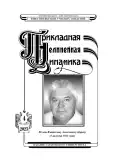Turing instability in the one-parameter Gierer–Meinhardt system
- Authors: Revina S.V.1, Ryabov A.S.1
-
Affiliations:
- Southern Federal University
- Issue: Vol 31, No 4 (2023)
- Pages: 501-522
- Section: Articles
- URL: https://journals.rcsi.science/0869-6632/article/view/250979
- DOI: https://doi.org/10.18500/0869-6632-003053
- EDN: https://elibrary.ru/WZPQWD
- ID: 250979
Cite item
Full Text
Abstract
About the authors
Svetlana Vasilyevna Revina
Southern Federal University
ORCID iD: 0000-0002-9216-8892
Scopus Author ID: 6602482421
ResearcherId: C-8488-2018
ul. Bol`shaya Sadovaya 105/42, Rostov-on-Don, 344006, Russia
Anatoly Sergeevich Ryabov
Southern Federal University
ORCID iD: 0009-0000-9435-9513
ul. Bol`shaya Sadovaya 105/42, Rostov-on-Don, 344006, Russia
References
- Wei J., Winter M. Mathematical Aspects of Pattern Formation in Biological Systems. London: Springer, 2014. 319 p. doi: 10.1007/978-1-4471-5526-3.
- Костин В. А., Осипов Г. В. Неустойчивость однородного состояния и двухдоменные пространственно-временные структуры в реакционно-диффузионных системах с глобальной связью // Известия вузов. ПНД. 2021. T. 29, № 1. С. 186–207. doi: 10.18500/0869-6632-2021- 29-1-186-207.
- Цибулин В. Г., Ха Т. Д., Зеленчук П. А. Нелинейная динамика системы хищник–жертва на неоднородном ареале и сценарии локального взаимодействия видов // Известия вузов. ПНД. 2021. T. 29, № 5. С. 751–764. doi: 10.18500/0869-6632-2021-29-5-751-764.
- Казарников А. В., Ревина С. В. Возникновение автоколебаний в системе Рэлея с диффузией // Вестник ЮУрГУ. Сер. «Математическое моделирование и программирование». 2016. Т. 9, № 2. С. 16–28. doi: 10.14529/mmp160202.
- Казарников А. В., Ревина С. В. Асимптотика стационарных решений в системе Рэлея с диффузией // Известия вузов. Северо-Кавказский регион. Естественные науки. 2016. № 3 (191). С. 13–19. doi: 10.18522/0321-3005-2016-3-13-19.
- Казарников А. В., Ревина С. В. Бифуркации в системе Рэлея с диффузией // Вестник Удмуртского университета. Математика. Механика. Компьютерные науки. 2017. Т. 27, № 4. С. 499–514. doi: 10.20537/vm170402.
- Казарников А. В., Ревина С. В. Монотонная неустойчивость в системе ФитцХью-Нагумо с диффузией // Известия вузов. Северо-Кавказский регион. Естественные науки. 2018. № 4 (200). С. 18–24. doi: 10.23683/0321-3005-2018-4-18-24.
- Turing A. M. The chemical basis of morphogenesis // Phil. Trans. R. Soc. Lond. B. 1952. Vol. 237, no. 641. P. 37–72. doi: 10.1098/rstb.1952.0012.
- Murray J. D. Mathematical Biology II: Spatial Models and Biomedical Applications. 3d edition. New York: Springer, 2003. 814 p. doi: 10.1007/b98869.
- Ревина С. В., Лысенко С. А. Достаточные условия неустойчивости Тьюринга для системы Шнакенберга // Вестник Удмуртского университета. Математика. Механика. Компьютерные науки. 2021. Т. 31, № 3. С. 424–442. doi: 10.35634/vm210306.
- Ревина С. В. Область диффузионной неустойчивости для систем параболических уравнений // Владикавказский математический журнал. 2022. Т. 24, № 4. С. 117–126. DOI: 10.46698/ d6373-9335-7338-n.
- Gierer A., Meinhardt H. A theory of biological pattern formation // Kybernetik. 1972. Vol. 12, no. 1. P. 30–39. doi: 10.1007/BF00289234.
- Meinhardt H. Models of biological pattern formation: From elementary steps to the organization of embryonic axes // Current Topics in Developmental Biology. 2008. Vol. 81. P. 1–63. doi: 10.1016/S0070-2153(07)81001-5.
- Gomez D., Ward M. J., Wei J. An asymptotic analysis of localized three-dimensional spot patterns for the Gierer–Meinhardt model: Existence, linear stability, and slow dynamics // SIAM Journal on Applied Mathematics. 2021. Vol. 81, no. 2. P. 378–406. doi: 10.1137/20M135707X.
- Chen M., Wu R., Chen L. Pattern dynamics in a diffusive Gierer–Meinhardt model // International Journal of Bifurcation and Chaos. 2020. Vol. 30, no. 12. P. 2030035. doi: 10.1142/S02181274 20300359.
- Юдович В. И. Пример потери устойчивости и рождения вторичного течения жидкости в замкнутом сосуде // Математический сборник (новая серия). 1967. Т. 74(116), № 4. С. 565–579.
- Юдович В. И. Исследование автоколебаний сплошной среды, возникающих при потере устойчивости стационарного режима // Прикладная математика и механика. 1972. Т. 36, № 3. С. 450–459.
- Revina S. V. Long wavelength asymptotics of self-oscillations of viscous incompressible fluid // In: Kusraev A. G., Totieva Z. D. (eds) Operator Theory and Differential Equations. Trends in Mathematics. Cham: Birkhauser, 2021. P. 185–203. doi: 10.1007/978-3-030-49763-7_15.
Supplementary files










